Abstract
The mechanism whereby the vasoconstrictor response to angiotensin II (AII) is influenced by sodium balance or disease is unclear. To explore this question, the renal vascular responses (RVR) to intrarenal injections of subpressor doses of AII and norepinephrine were studied in dogs with an electromagnetic flowmeter. Acute and chronic sodium depletion increased plasma renin activity (PRA) and blunted the RVR to AII, while acute sodium repletion and chronic sodium excess plus desoxycorticosterone acetate decreased PRA and enhanced the RVR to AII. The magnitude of the RVR to AII was inversely related to PRA. The RVR to norepinephrine was unaffected by sodium balance and was not related to PRA. Inhibition of the conversion of angiotensin I to AII by SQ 20,881 during sodium depletion lowered mean arterial blood pressure (MABP), increased renal blood flow (RBF), and enhanced the RVR to AII but not to norepinephrine. Administration of bradykinin to chronically sodium-depleted dogs also lowered the MABP and increased RBF but had no effect on the RVR to AII. SQ 20,881 had no effect on MABP, RBF, or the RVR to AII in the dogs with chronic sodium excess and desoxycorticosterone acetate. Administration of indomethacin to chronically sodium-depleted dogs lowered RBF but did not influence the RVR to AII. The results indicate that the RVR to AII is selectively influenced by sodium balance and that the magnitude of the response is inversely related to the availability of endogenous AII. The data did not suggest that the variations in the RVR to AII were because of direct effects of sodium on vascular contraction, changes in the number of vascular AII receptors, or the renal prostaglandins. The results are consistent with the hypothesis that the vasoconstrictor effect of AII in the renal vasculature is primarily dependent upon the degree to which the AII vascular receptors are occupied by endogenous hormone.
Full text
PDF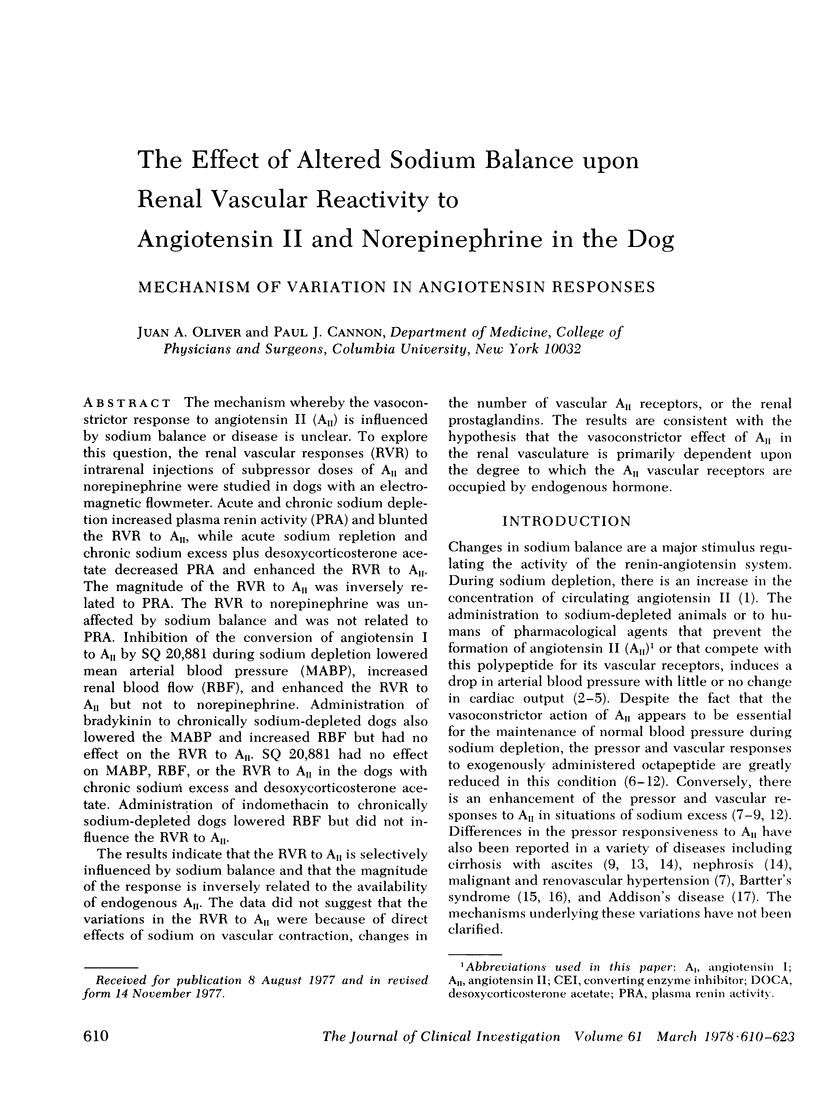
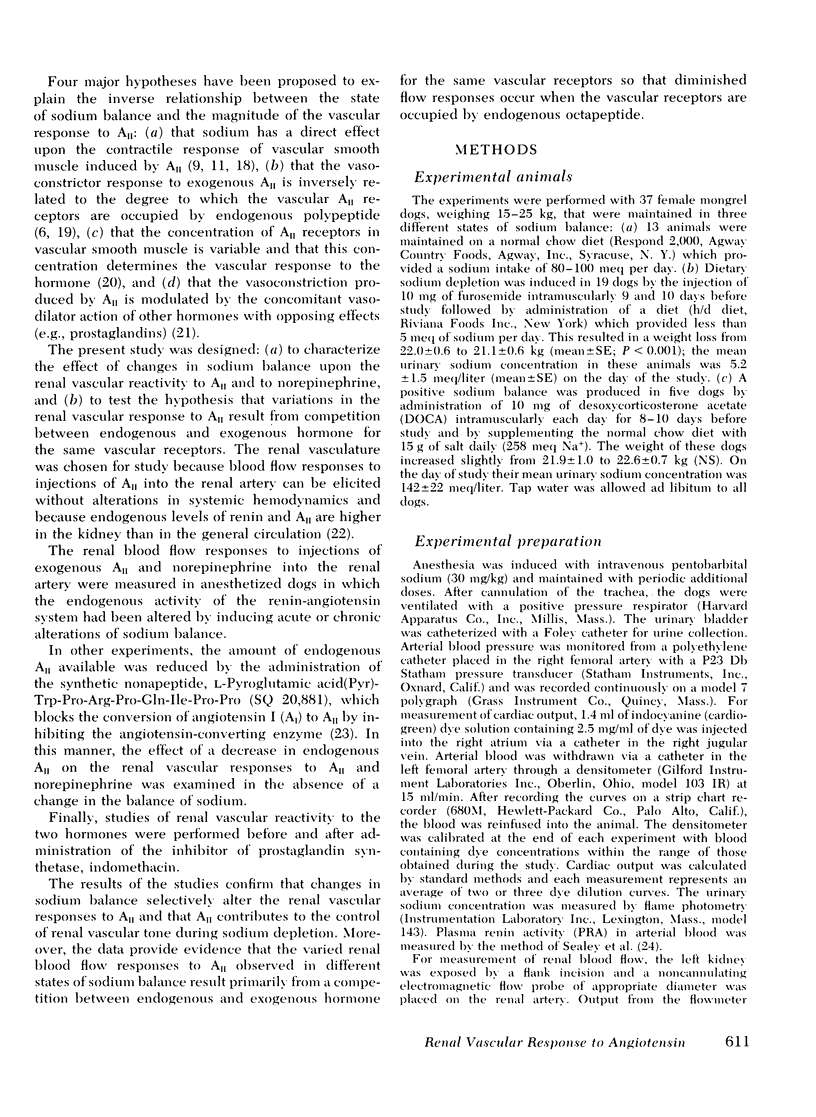
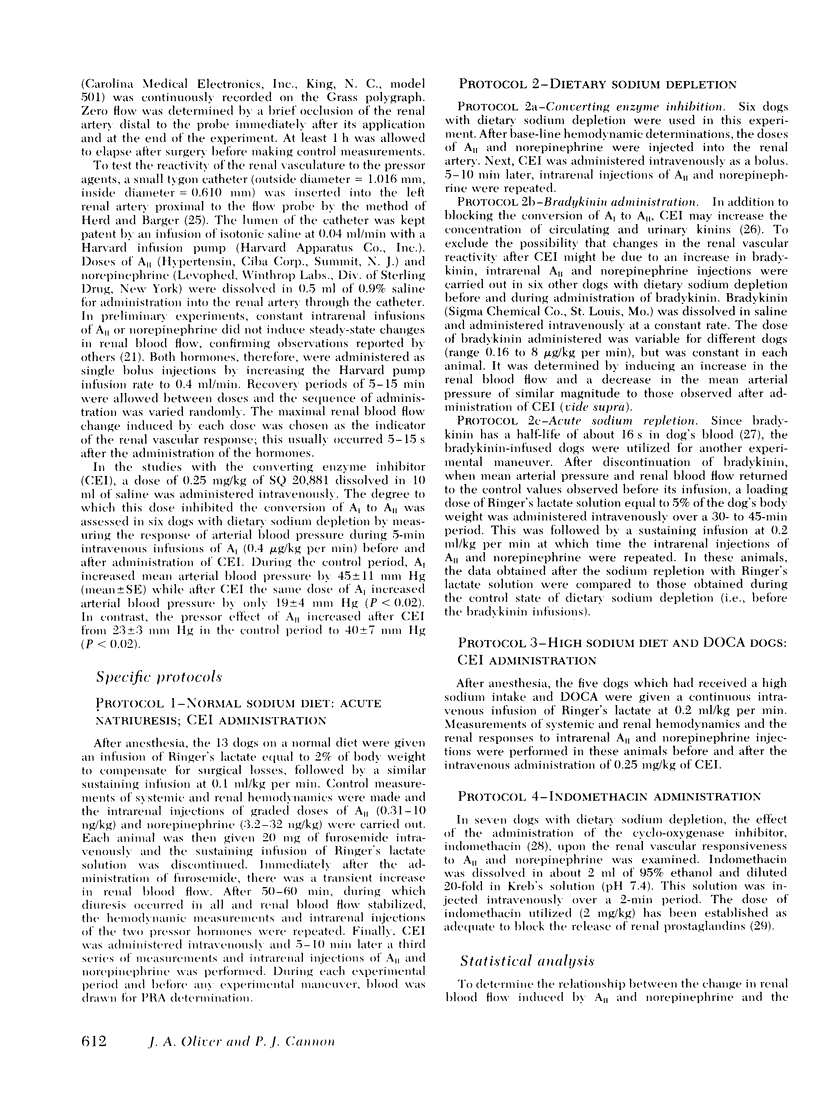

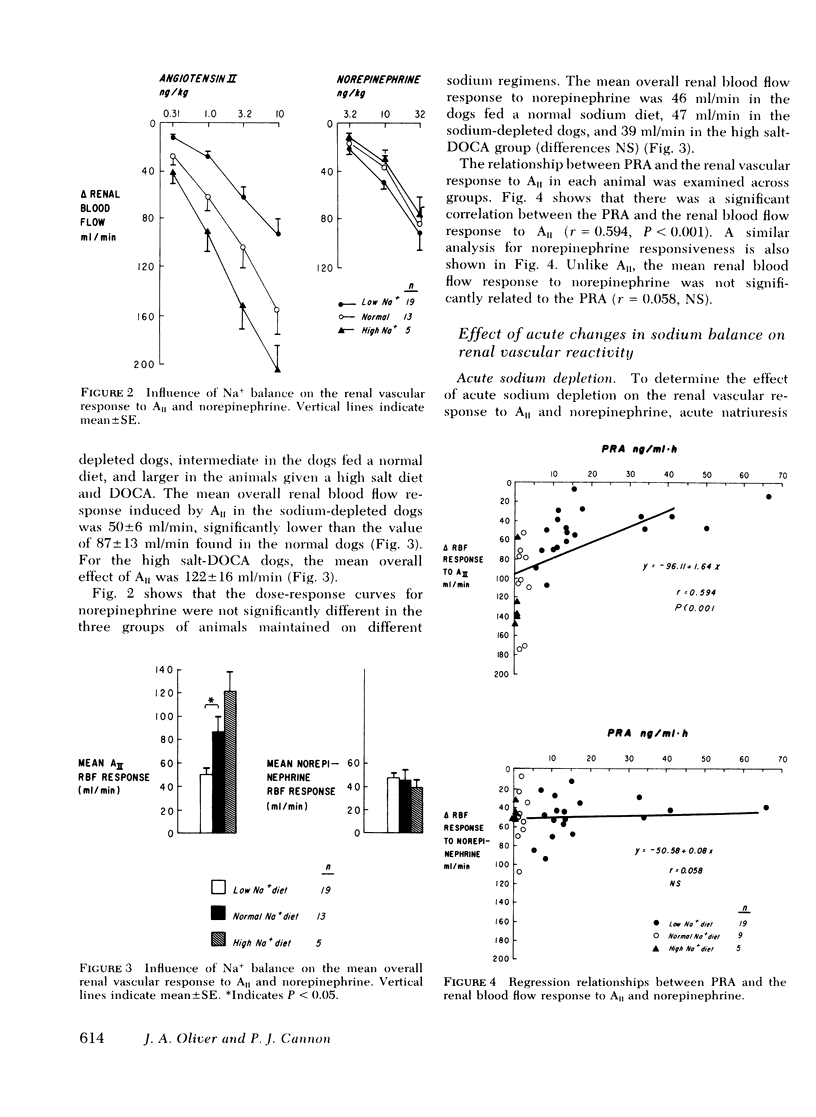
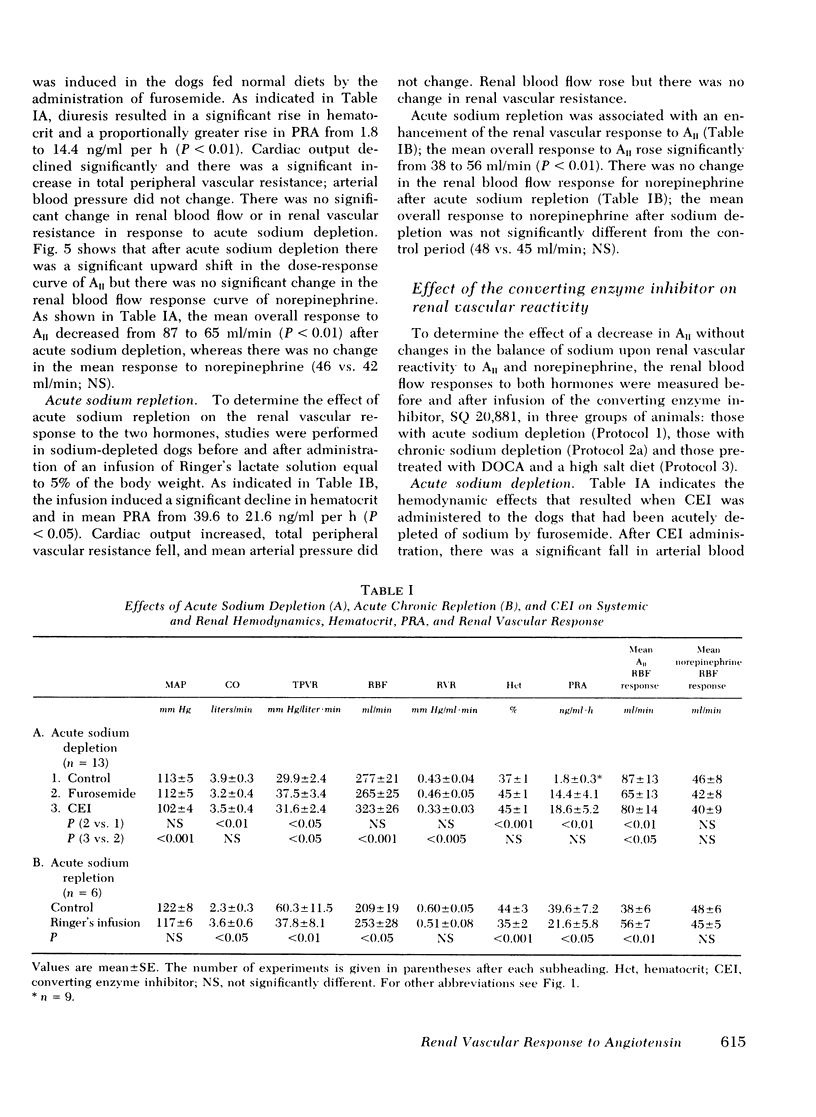

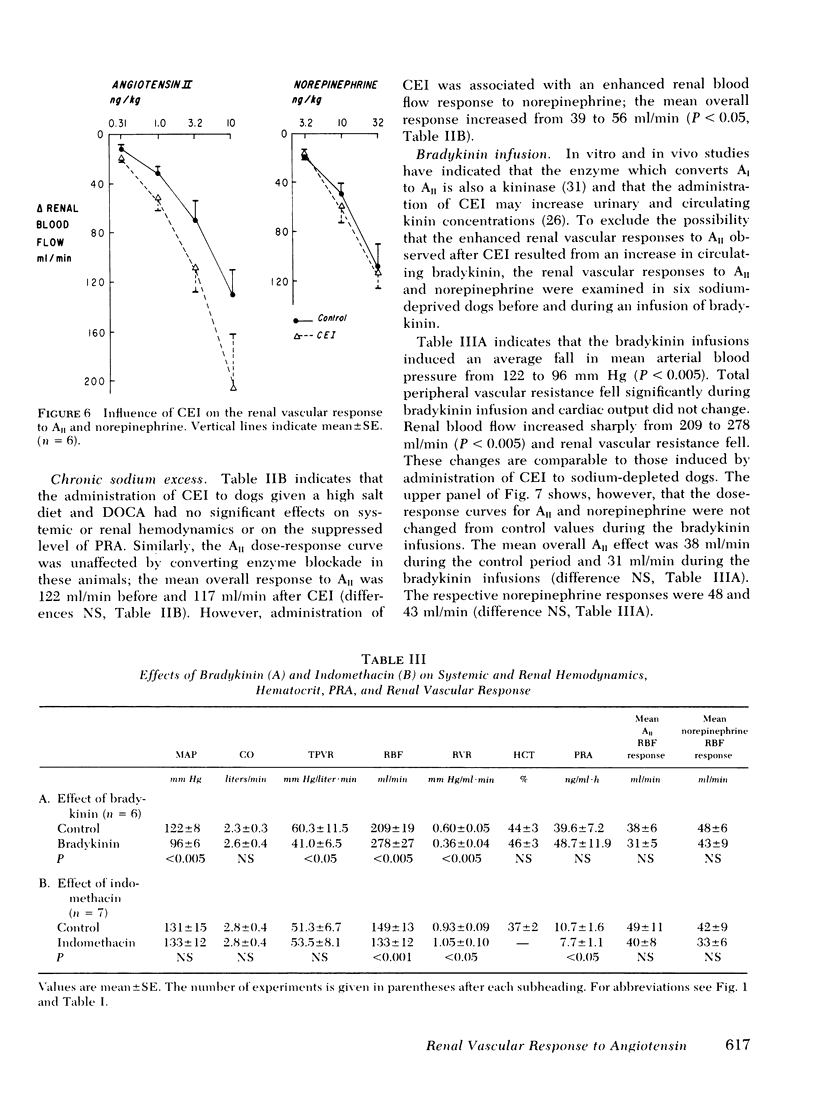

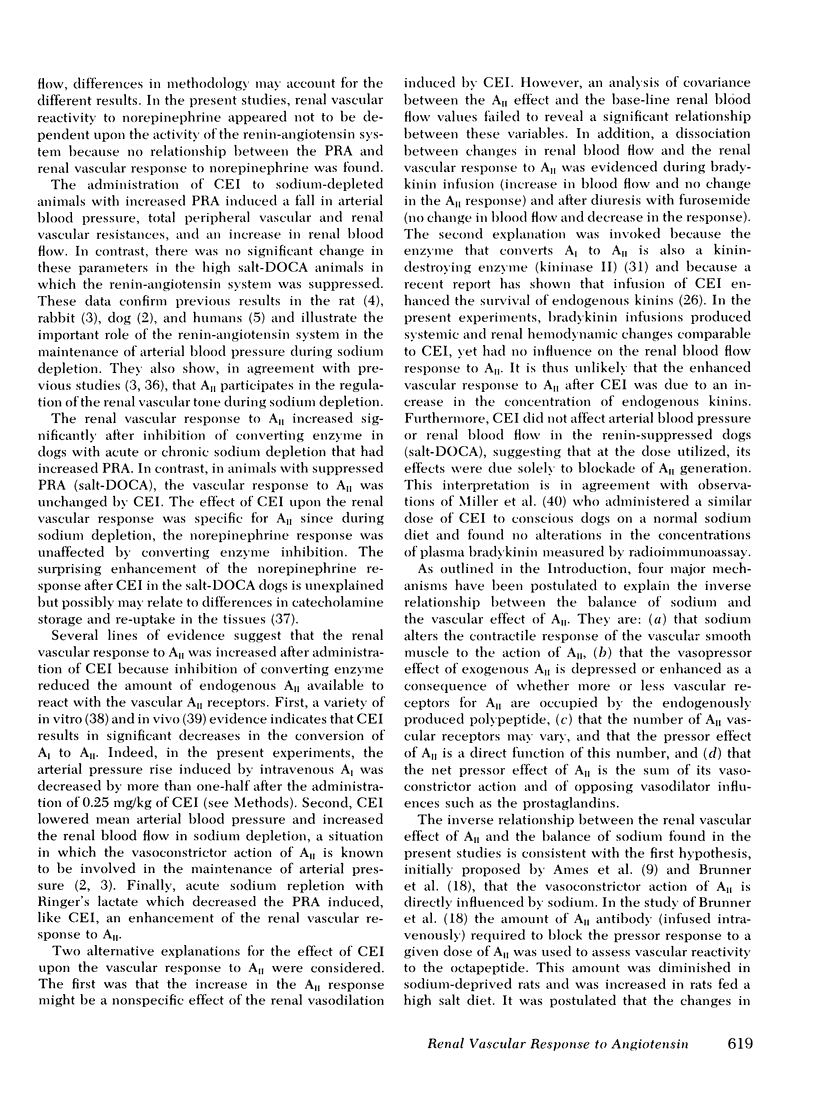
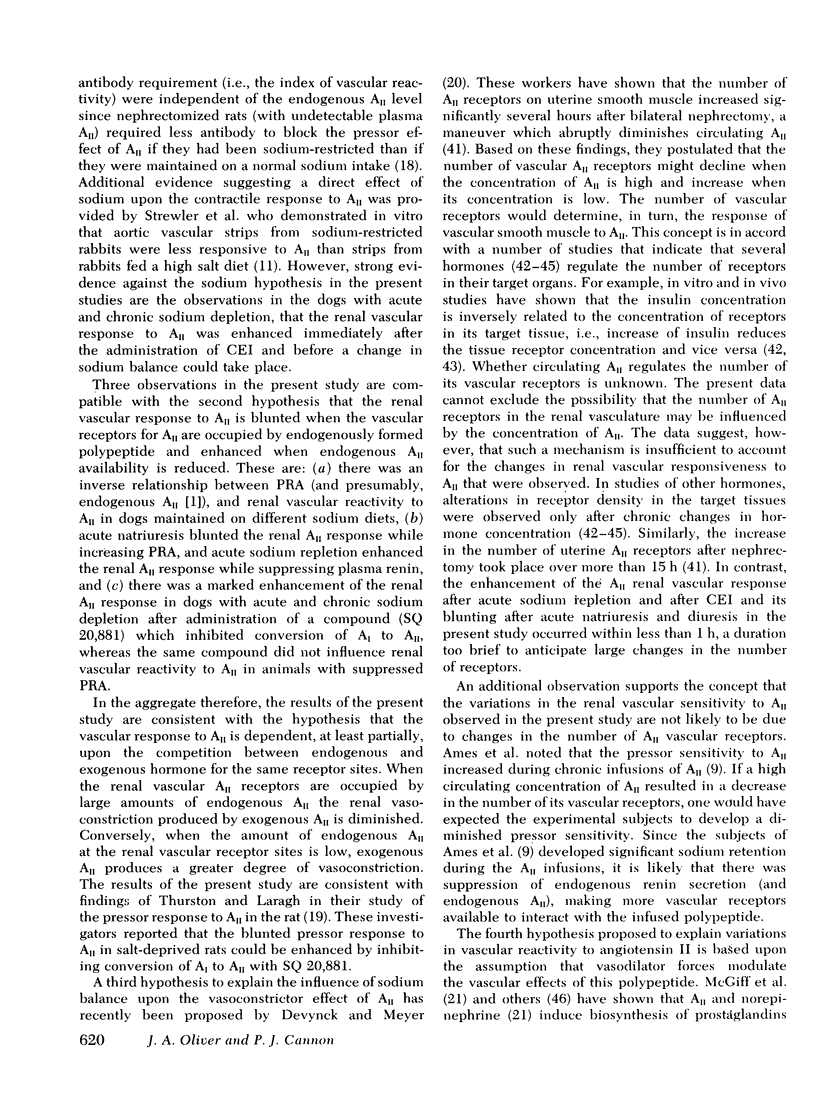
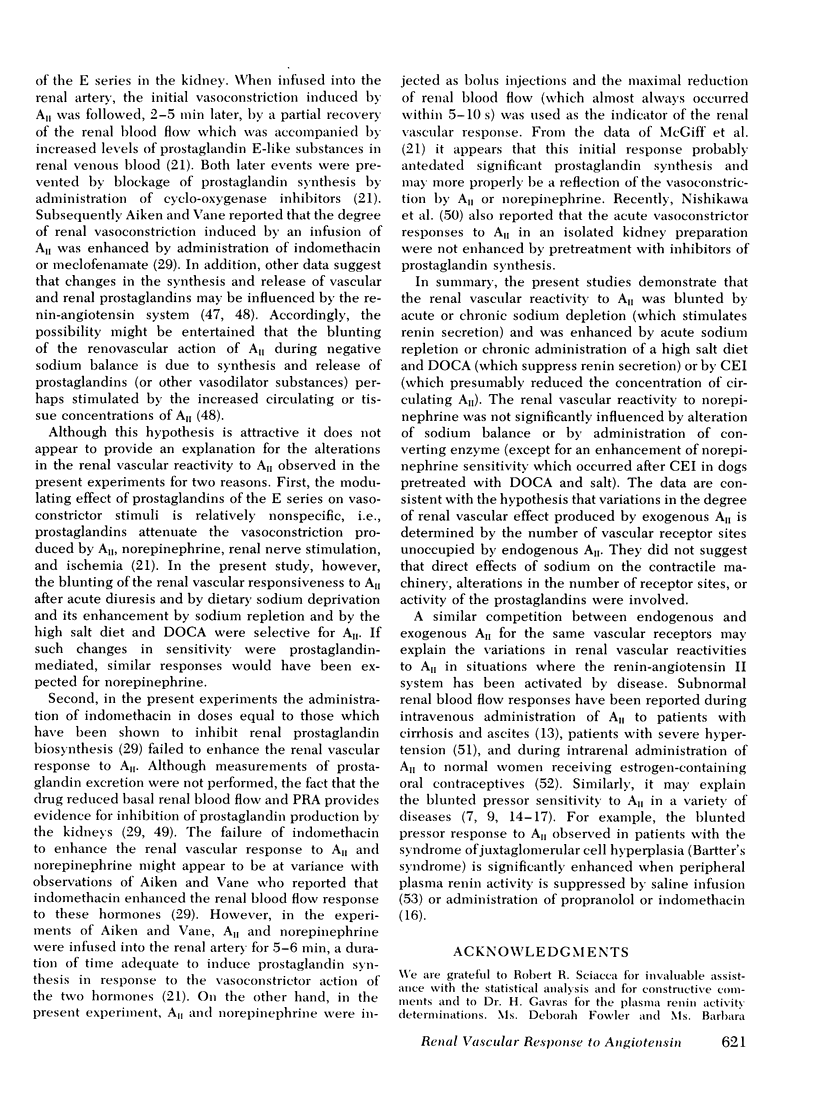

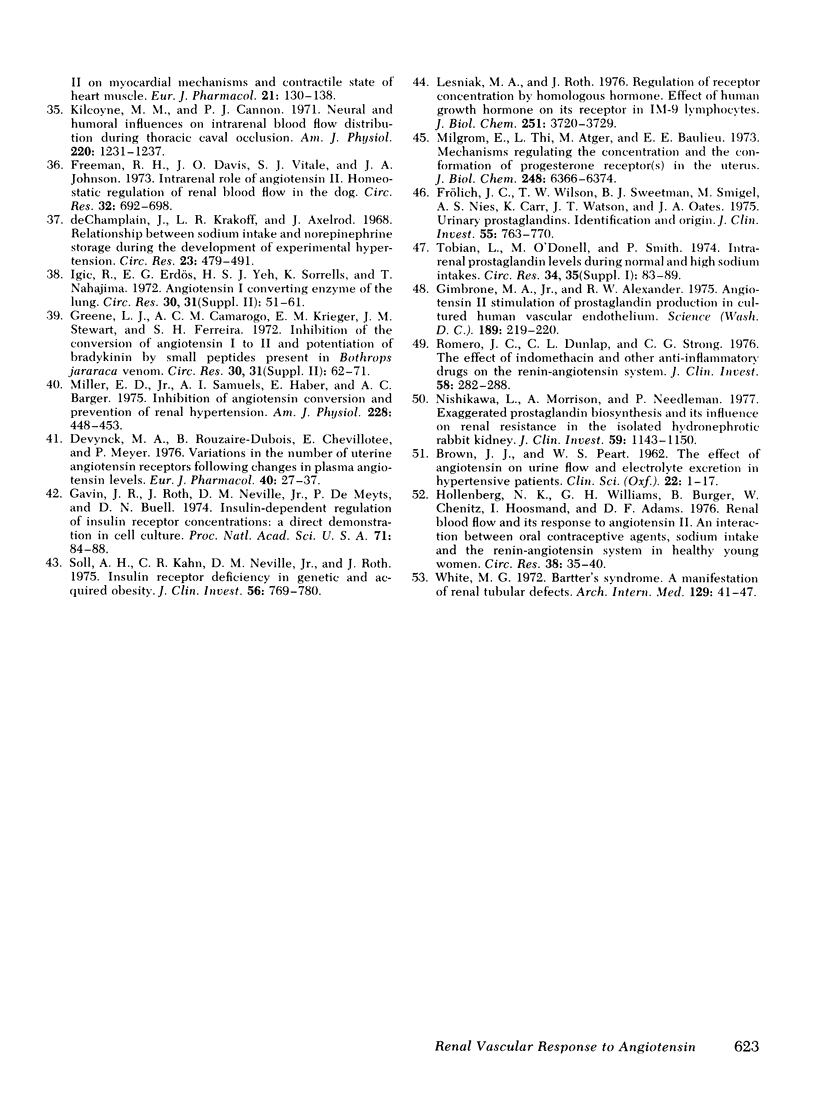
Selected References
These references are in PubMed. This may not be the complete list of references from this article.
- AMES R. P., BORKOWSKI A. J., SICINSKI A. M., LARAGH J. H. PROLONGED INFUSIONS OF ANGIOTENSIN II AND NOREPINEPHRINE AND BLOOD PRESSURE, ELECTROLYTE BALANCE, AND ALDOSTERONE AND CORTISOL SECRETION IN NORMAL MAN AND IN CIRRHOSIS WITH ASCITES. J Clin Invest. 1965 Jul;44:1171–1186. doi: 10.1172/JCI105224. [DOI] [PMC free article] [PubMed] [Google Scholar]
- Aiken J. W., Vane J. R. Intrarenal prostaglandin release attenuates the renal vasoconstrictor activity of angiotensin. J Pharmacol Exp Ther. 1973 Mar;184(3):678–687. [PubMed] [Google Scholar]
- BARTTER F. C., PRONOVE P., GILL J. R., Jr, MACCARDLE R. C. Hyperplasia of the juxtaglomerular complex with hyperaldosteronism and hypokalemic alkalosis. A new syndrome. Am J Med. 1962 Dec;33:811–828. doi: 10.1016/0002-9343(62)90214-0. [DOI] [PubMed] [Google Scholar]
- BROWN J. J., PEART W. S. The effect of angiotension on urine flow and electrolyte excretion in hypertensive patients. Clin Sci. 1962 Feb;22:1–17. [PubMed] [Google Scholar]
- Bailie M. D., Rector F. C., Jr, Seldin D. W. Angiotensin II in arterial and renal venous plasma and renal lymph in the dog. J Clin Invest. 1971 Jan;50(1):119–126. doi: 10.1172/JCI106465. [DOI] [PMC free article] [PubMed] [Google Scholar]
- Brunner H. R., Chang P., Wallach R., Sealey J. E., Laragh J. H. Angiotensin II vascular receptors: their avidity in relationship to sodium balance, the autonomic nervous system, and hypertension. J Clin Invest. 1972 Jan;51(1):58–67. doi: 10.1172/JCI106797. [DOI] [PMC free article] [PubMed] [Google Scholar]
- Coleman T. G., Cowley A. W., Jr, Guyton A. C. Angiotensin and the hemodynamics of chronic salt deprivation. Am J Physiol. 1975 Jul;229(1):167–171. doi: 10.1152/ajplegacy.1975.229.1.167. [DOI] [PubMed] [Google Scholar]
- DAVIS J. O., HARTROFT P. M., TITUS E. O., CARPENTER C. C., AYERS C. R., SPIEGEL H. E. The role of the renin-angiotensin system in the control of aldosterone secretion. J Clin Invest. 1962 Feb;41:378–389. doi: 10.1172/JCI104492. [DOI] [PMC free article] [PubMed] [Google Scholar]
- Devynck M. A., Meyer P. Angiotensin receptors in vascular tissue. Am J Med. 1976 Nov;61(5):758–767. doi: 10.1016/0002-9343(76)90157-1. [DOI] [PubMed] [Google Scholar]
- Devynck M. A., Rouzaire-Dubois B., Chevillotte E., Meyer P. Variations in the number of uterine angiotensin receptors following changes in plasma angiotensin levels. Eur J Pharmacol. 1976 Nov;40(1):27–37. doi: 10.1016/0014-2999(76)90350-2. [DOI] [PubMed] [Google Scholar]
- Drimal J., Boska D. Effects of angiotensin-II on myocardial mechanics and contractile state of heart muscle. Eur J Pharmacol. 1973 Feb;21(2):130–138. doi: 10.1016/0014-2999(73)90217-3. [DOI] [PubMed] [Google Scholar]
- Fichman M. P., Telfer N., Zia P., Speckart P., Golub M., Rude R. Role of prostaglandins in the pathogenesis of Bartter's syndrome. Am J Med. 1976 May 31;60(6):785–797. doi: 10.1016/0002-9343(76)90892-5. [DOI] [PubMed] [Google Scholar]
- Freeman R. H., Davis J. O., Vitale S. J., Johnson J. A. Intrarenal role of angiotensin II. Homeostatic regulation of renal blood flow in the dog. Circ Res. 1973 Jun;32(6):692–698. doi: 10.1161/01.res.32.6.692. [DOI] [PubMed] [Google Scholar]
- Frölich J. C., Wilson T. W., Sweetman B. J., Smigel M., Nies A. S., Carr K., Watson J. T., Oates J. A. Urinary prostaglandins. Identification and origin. J Clin Invest. 1975 Apr;55(4):763–770. doi: 10.1172/JCI107987. [DOI] [PMC free article] [PubMed] [Google Scholar]
- Gavin J. R., 3rd, Roth J., Neville D. M., Jr, de Meyts P., Buell D. N. Insulin-dependent regulation of insulin receptor concentrations: a direct demonstration in cell culture. Proc Natl Acad Sci U S A. 1974 Jan;71(1):84–88. doi: 10.1073/pnas.71.1.84. [DOI] [PMC free article] [PubMed] [Google Scholar]
- Gimbrone M. A., Jr, Alexander R. W. Angiotensin II stimulation of prostaglandin production in cultured human vascular endothelium. Science. 1975 Jul 18;189(4198):219–220. doi: 10.1126/science.1138377. [DOI] [PubMed] [Google Scholar]
- Gocke D. J., Gerten J., Sherwood L. M., Laragh J. H. Physiological and pathological variations of plasma angiotensin II in man. Correlation with renin activity and sodium balance. Circ Res. 1969 May;24(5 Suppl):131–148. [PubMed] [Google Scholar]
- HERD J. A., BARGER A. C. SIMPLIFIED TECHNIQUE FOR CHRONIC CATHETERIZATION OF BLOOD VESSELS. J Appl Physiol. 1964 Jul;19:791–792. doi: 10.1152/jappl.1964.19.4.791. [DOI] [PubMed] [Google Scholar]
- Hamberg M., Samuelsson B. Prostaglandin endoperoxides. Novel transformations of arachidonic acid in human platelets. Proc Natl Acad Sci U S A. 1974 Sep;71(9):3400–3404. doi: 10.1073/pnas.71.9.3400. [DOI] [PMC free article] [PubMed] [Google Scholar]
- Hollenberg N. K., Chenitz W. R., Adams D. F., Williams G. H. Reciprocal influence of salt intake on adrenal glomerulosa and renal vascular responses to angiotensin II in normal man. J Clin Invest. 1974 Jul;54(1):34–42. doi: 10.1172/JCI107748. [DOI] [PMC free article] [PubMed] [Google Scholar]
- Hollenberg N. K., Solomon H. S., Adams D. F., Abrams H. L., Merrill J. P. Renal vascular responses to angiotensin and norepinephrine in normal man. Effect of sodium intake. Circ Res. 1972 Nov;31(5):750–757. doi: 10.1161/01.res.31.5.750. [DOI] [PubMed] [Google Scholar]
- Hollenberg N. K., Williams G. H., Burger B., Chenitz W., Hoosmand I., Adams D. F. Renal blood flow and its response to angiotensin II. An interaction between oral contraceptive agents, sodium intake, and the renin-angiotensin system in healthy young women. Circ Res. 1976 Jan;38(1):35–40. doi: 10.1161/01.res.38.1.35. [DOI] [PubMed] [Google Scholar]
- JOHNSTON C. I., JOSE A. D. REDUCED VASCULAR RESPONSE TO ANGIOTENSIN II IN SECONDARY HYPERALDOSTERONISM. J Clin Invest. 1963 Sep;42:1411–1420. doi: 10.1172/JCI104826. [DOI] [PMC free article] [PubMed] [Google Scholar]
- Johnson J. A., Davis J. O. Effects of a specific competitive antagonist of angiotensin II on arterial pressure and adrenal steroid secretion in dogs. Circ Res. 1973 May 5;32(Suppl):159–168. [PubMed] [Google Scholar]
- KAPLAN N. M., SILAH J. G. THE EFFECT OF ANGIOTENSIN II ON THE BLOOD PRESSURE IN HUMANS WITH HYPERTENSIVE DISEASE. J Clin Invest. 1964 Apr;43:659–669. doi: 10.1172/JCI104951. [DOI] [PMC free article] [PubMed] [Google Scholar]
- KUCHEL O., HORKY K., PAZOUREK M., GREGOROVA I. PRESSOR HYPOREACTIVITY TO ANGIOTENSIN ADDISON'S DISEASE. Lancet. 1964 Dec 19;2(7373):1316–1317. doi: 10.1016/s0140-6736(64)91107-9. [DOI] [PubMed] [Google Scholar]
- Laragh J. H., Cannon P. J., Bentzel C. J., Sicinski A. M., Meltzer J. I. ANGIOTENSIN II, NOREPINEPHRINE, AND RENAL TRANSPORT OF ELECTROLYTES AND WATER IN NORMAL MAN AND IN CIRRHOSIS WITH ASCITES. J Clin Invest. 1963 Jul;42(7):1179–1192. doi: 10.1172/JCI104803. [DOI] [PMC free article] [PubMed] [Google Scholar]
- Lesniak M. A., Roth J. Regulation of receptor concentration by homologous hormone. Effect of human growth hormone on its receptor in IM-9 lymphocytes. J Biol Chem. 1976 Jun 25;251(12):3720–3729. [PubMed] [Google Scholar]
- MCCARTHY D. A., POTTER D. E., NICOLAIDES E. D. AN IN VIVO ESTIMATION OF THE POTENCIES AND HALF-LIVES OF SYNTHETIC BRADYKININ AND KALLIDIN. J Pharmacol Exp Ther. 1965 Apr;148:117–122. [PubMed] [Google Scholar]
- McGiff J. C., Malik K. U., Terragno N. A. Prostaglandins as determinants of vascular reactivity. Fed Proc. 1976 Oct;35(12):2382–2387. [PubMed] [Google Scholar]
- Milgrom E., Thi L., Atger M., Baulieu E. E. Mechanisms regulating the concentration and the conformation of progesterone receptor(s) in the uterus. J Biol Chem. 1973 Sep 25;248(18):6366–6374. [PubMed] [Google Scholar]
- Miller E. D., Jr, Samuels A. I., Haber E., Barger A. C. Inhibition of angiotensin conversion and prevention of renal hypertension. Am J Physiol. 1975 Feb;228(2):448–453. doi: 10.1152/ajplegacy.1975.228.2.448. [DOI] [PubMed] [Google Scholar]
- Mimran A., Guiod L., Hollenberg N. K. The role of angiotensin in the cardiovascular and renal response to salt restriction. Kidney Int. 1974 May;5(5):348–355. doi: 10.1038/ki.1974.50. [DOI] [PubMed] [Google Scholar]
- Nasjletti A., Colina-Chourio J., McGiff J. C. Disappearance of bradykinin in the renal circulation of dogs. Effects of kininase inhibition. Circ Res. 1975 Jul;37(1):59–65. doi: 10.1161/01.res.37.1.59. [DOI] [PubMed] [Google Scholar]
- Nishikawa K., Morrison A., Needleman P. Exaggerated prostaglandin biosynthesis and its influence on renal resistance in the isolated hydronephrotic rabbit kidney. J Clin Invest. 1977 Jun;59(6):1143–1150. doi: 10.1172/JCI108738. [DOI] [PMC free article] [PubMed] [Google Scholar]
- Ondetti M. A., Williams N. J., Sabo E. F., Pluscec J., Weaver E. R., Kocy O. Angiotensin-converting enzyme inhibitors from the venom of Bothrops jararaca. Isolation, elucidation of structure, and synthesis. Biochemistry. 1971 Oct 26;10(22):4033–4039. doi: 10.1021/bi00798a004. [DOI] [PubMed] [Google Scholar]
- Reid W. D., Laragh J. H. Sodium and potassium intake, blood pressure, and pressor response to angiotensin. Proc Soc Exp Biol Med. 1965 Oct;120(1):26–29. doi: 10.3181/00379727-120-30434. [DOI] [PubMed] [Google Scholar]
- Reit E. Actions of angiotensin on the adrenal medulla and autonomic ganglia. Fed Proc. 1972 Jul-Aug;31(4):1338–1343. [PubMed] [Google Scholar]
- Romero J. C., Dunlap C. L., Strong C. G. The effect of indomethacin and other anti-inflammatory drugs on the renin-angiotensin system. J Clin Invest. 1976 Aug;58(2):282–288. doi: 10.1172/JCI108470. [DOI] [PMC free article] [PubMed] [Google Scholar]
- Sancho J., Re R., Burton J., Barger A. C., Haber E. The role of the renin-angiotensin-aldosterone system in cardiovascular homeostasis in normal human subjects. Circulation. 1976 Mar;53(3):400–405. doi: 10.1161/01.cir.53.3.400. [DOI] [PubMed] [Google Scholar]
- Sealey J. E., Gerten-Banes J., Laragh J. H. The renin system: Variations in man measured by radioimmunoassay or bioassay. Kidney Int. 1972 Apr;1(4):240–253. doi: 10.1038/ki.1972.34. [DOI] [PubMed] [Google Scholar]
- Severs W. B., Daniels-Severs A. E. Effects of angiotensin on the central nervous system. Pharmacol Rev. 1973 Sep;25(3):415–449. [PubMed] [Google Scholar]
- Soli A. H., Kahn C. R., Neville D. M., Jr, Roth J. Insulin receptor deficiency in genetic and acquired obesity. J Clin Invest. 1975 Oct;56(4):769–780. doi: 10.1172/JCI108155. [DOI] [PMC free article] [PubMed] [Google Scholar]
- Strewler G. J., Hinrichs K. J., Guiod L. R., Hollenberg N. K. Sodium intake and vascular smooth muscle responsiveness to norepinephrine and angiotensin in the rabbit. Circ Res. 1972 Nov;31(5):758–766. doi: 10.1161/01.res.31.5.758. [DOI] [PubMed] [Google Scholar]
- Thurston H., Laragh J. H. Prior receptor occupancy as a determinant of the pressor activity of infused angiotensin II in the rat. Circ Res. 1975 Jan;36(1):113–117. doi: 10.1161/01.res.36.1.113. [DOI] [PubMed] [Google Scholar]
- White M. G. Bartter's syndrome. A manifestation of renal tubular defects. Arch Intern Med. 1972 Jan;129(1):41–47. doi: 10.1001/archinte.129.1.41. [DOI] [PubMed] [Google Scholar]
- Yang H. Y., Erdös E. G., Levin Y. Characterization of a dipeptide hydrolase (kininase II: angiotensin I converting enzyme). J Pharmacol Exp Ther. 1971 Apr;177(1):291–300. [PubMed] [Google Scholar]


